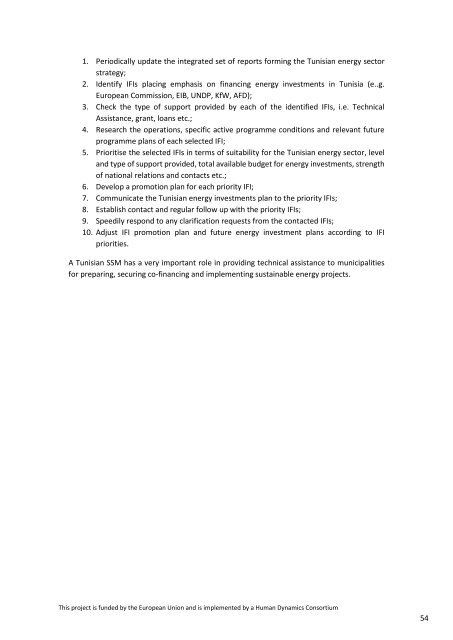311017_CESMED Funding_Mechanisms_Final
You also want an ePaper? Increase the reach of your titles
YUMPU automatically turns print PDFs into web optimized ePapers that Google loves.
8. Communicate the action funding request to the priority IFI;<br />
9. Establish contact and regular follow up with the priority IFI;<br />
10. Speedily respond to any clarification requests from the contacted IFI;<br />
11. Allow time for completion of the IFI’s evaluation cycle;<br />
12. Once concluded evaluation (positively or negatively) propose additional alternative<br />
actions for subsequent evaluation.<br />
Indicatively, IFIs currently active in Tunisia include the European Commission, EIB, UNDP, KfW,<br />
AFD, as well as a number of Arab and Islamic banks. Other potential sources for funding the<br />
implementation of municipality SEAP actions are twinned European municipalities,<br />
international NGOs and other charity foundations (i.e. out of the formal donor – government<br />
channel). Another possibility is seeking to increase the current municipality revenues through<br />
other innovative ways (e.g. PPPs).<br />
10.4. National Guidelines for Securing <strong>Funding</strong> for Municipal Energy Projects<br />
Tunisia prepares a medium term (5-year) national strategic development plan (TUNISIA 2020<br />
covering the 2016 – 2020 period being the current), structured along the lines of 5 pillars:<br />
1. Good governance, public administration reform and anti-corruption measures;<br />
2. Transition from a low-cost country to an economic hub;<br />
3. Human development and social inclusion;<br />
4. Fulfilment of regional ambitions;<br />
5. Green economy and sustainable development.<br />
Subsequently, the 2030 energy strategy adopted in November 2016 aims at rebuilding the<br />
reserve of energies and strengthening Tunisia’s capacity to guarantee energy independence<br />
in terms of fossil energy and primary energy production through the revision of the role of the<br />
state which is called to simplify procedures for granting permits. The strategy aims to improve<br />
energy intensity by 3% per year during 2016-2030, save 17% of consumed energy by 2020,<br />
and produce 30% of Tunisia’s electricity from renewable energy sources by 2030.<br />
Furthermore, the ACTE programme was launched in May 2015 by ANME, CPSCL and DGPCL in<br />
order to strengthen the capacity of Tunisian municipalities to contribute towards the energy<br />
transition, energy efficiency and the use of renewable energies 27 . This is summarized in Annex<br />
A.4, based on the related deliverables from the present CES-MED project.<br />
Based on the above development priorities, clear signals are now available to the IFIs on<br />
funding needs for municipal energy investments in Tunisia. It is up to the Ministries of Energy,<br />
Mines & Renewable Energy (MEMER), Local Affairs & Environment (MALE) and Development,<br />
and Investment & International Cooperation (MDICI - focal point for all IFIs) to appropriately<br />
communicate these priorities to the IFIs, in order to increase total funds made available for<br />
Tunisian municipalities and increase their allocation for energy investments.<br />
The following steps are therefore necessary to secure international funding for the<br />
implementation of energy investments in Tunisia, including municipal energy projects with<br />
support from the SSM:<br />
27<br />
Manuel des procédures du programme ACTE destiné aux municipalités, current EU-financed CES-<br />
MED project, May 2017<br />
This project is funded by the European Union and is implemented by a Human Dynamics Consortium<br />
53

















